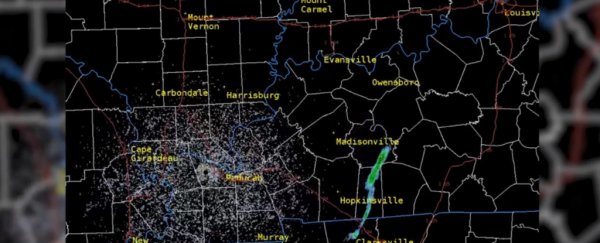The radar signature meandered over southern Illinois for 10 hours on Monday.
It definitely wasn't precipitation, the National Weather Service said.
But that seemed for days to be the only sure thing about the blob, which floated for nearly 140 miles (225 kilometres) before scattering into nothing after it crossed into western Kentucky.
So what was it?
Birds? Meteors?
The first volley of a coordinated campaign to distract military aircraft from alien sorties?
Chris Noles, a meteorologist at the National Weather Service outpost in Paducah, Kentucky, first observed the disturbance.
And it was … strange.
Objects in the sky have a certain amount of reflective potential for radar signals to bounce back from, Noles told The Washington Post on Wednesday.
And this disturbance had a lot of potential.
Solid objects with greater surface area cause those signals to come through stronger.
Interesting radar return over Wabash County IL, moving south off KPAH radar. pic.twitter.com/wmLGWtXxid
— NWS Paducah, KY (@NWSPaducah) December 10, 2018
So when you're watching severe weather crawl across the radar screen, Noles said, yellow and red typically show hail or snow. Those are strong.
Rain and drizzle are not so solid and appear as weaker signals, in blue and green hues.
This disturbance, then, was puzzling and churned with a core of yellow and red signatures as it pushed along a southeastern wind, producing radar signals from as high as 10,000 feet (3,000 metres).
Birds don't appear that way on radar, Noles said.
So: ̶b̶i̶r̶d̶s̶.
Meteors are pretty solid. But they don't move at 14 miles (22.5 kilometres) an hour.
So: ̶m̶e̶t̶e̶o̶r̶s̶.
North American Aerospace Defense Command, which oversees air sovereignty in the United States, said it was following the incident but did not have information on what the object could have been.
What about aliens then?
"NORAD does not track UFOs or alien aircraft," spokesman Michael Kucharek said, though he explained that NORAD would be aware of unauthorized aircraft in the United States.
Kucharek referred further questions to the Federal Aviation Administration, which referred back to NORAD.
(NORAD does, however, track Santa's flight across the world. But it's too early for Santa to show up on radar.)
So: ̶a̶l̶i̶e̶n̶s̶ ̶a̶n̶d̶ ̶S̶a̶n̶t̶a̶.
Back at the National Weather Service, Noles offered another explanation.
Perhaps the slow-moving band that tracked with wind patterns on that clear day was a countermeasure launched from a military aircraft.
Chaff is a cloud of light aluminum-coated material deployed in the air to fool and overwhelm radar signals that may be tracking the aircraft.
An incident in southern Missouri in the 1990s that Noles observed was similar, he said.
But an NWS report on chaff and its impact on weather radar said chaff typically lingers for two to five hours. Monday's incident was twice as long as the high end of that window.
A longer event is not unprecedented, however.
During a training exercise in 2013, a military aircraft launched chaff over Alabama, where it lingered in the atmosphere for about the same amount of time - 10 hours, according to the NWS report.
Two military installations relatively close to the path of the most recent radar anomaly - Scott Air Force Base in Illinois and Fort Campbell in Kentucky - told the Evansville Courier and Press that their aircraft were not responsible.
An Evansville meteorologist said he was told by an unnamed pilot that chaff came from a military C-130 transport aircraft but did not say where it originated.
The mystery continued Wednesday, even for those who would eventually know what really happened.
It was chaff released from a C-130H aircraft piloted by the 130th Airlift Wing of the West Virginia Air National Guard during a training operation, state guard spokeswoman Captain Holli Nelson said.
The pilots were required to expend the material, potentially for safety reasons, Nelson said, and received air traffic control permission to do so.
Officials at the National Guard Bureau began to piece together that news by the afternoon.
"I woke up, and I was having my coffee, picking through news and saw the headline myself," said Army Master Sergeant. Mike Houk, a Bureau spokesman. "And I didn't know what it was."
Now he does.
So: ̶m̶y̶s̶t̶e̶r̶y̶.
2018 © The Washington Post
This article was originally published by The Washington Post.
